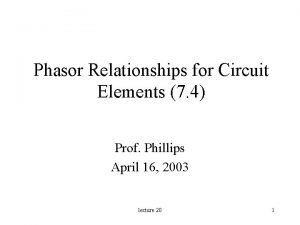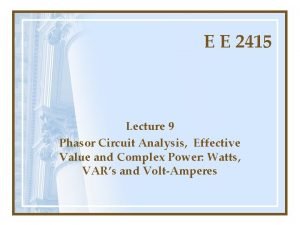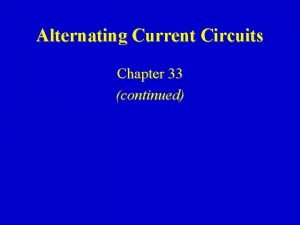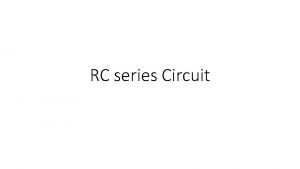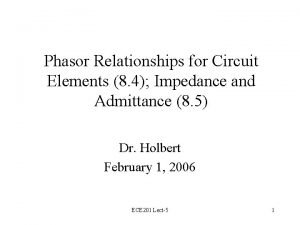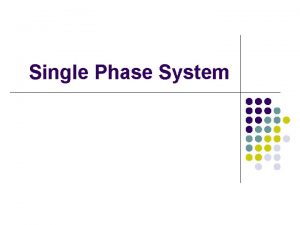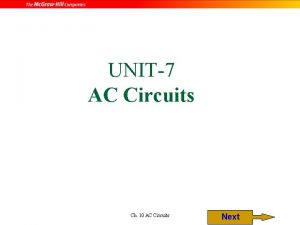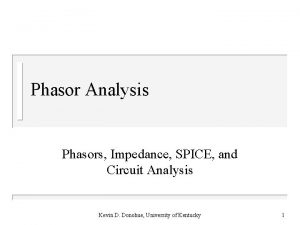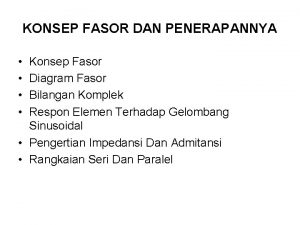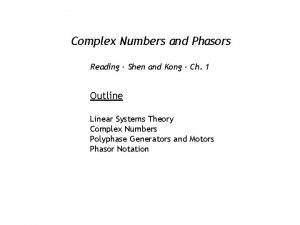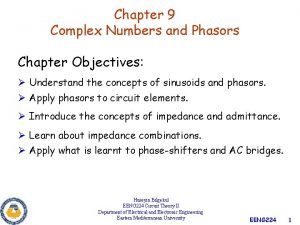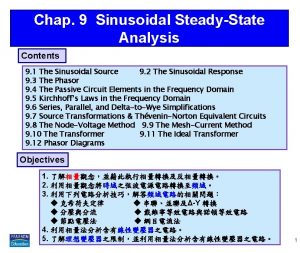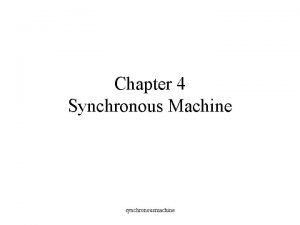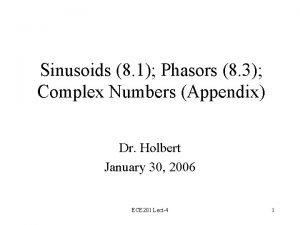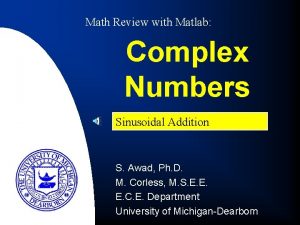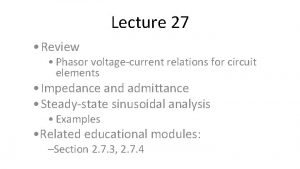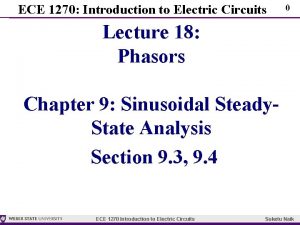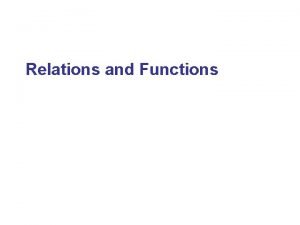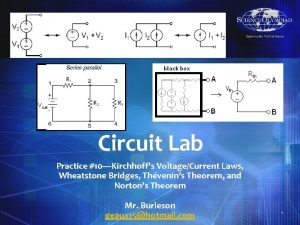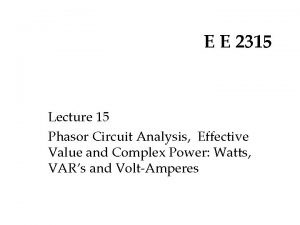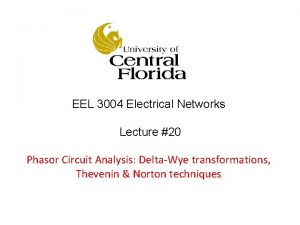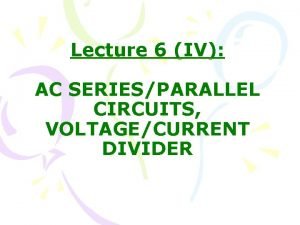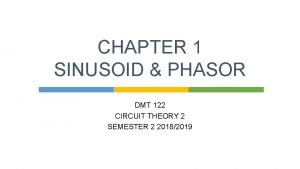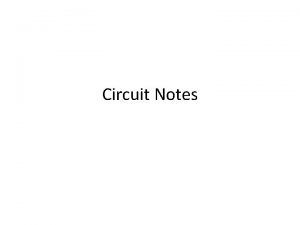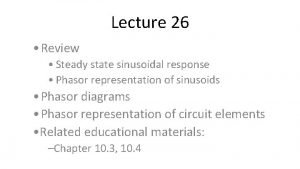Lecture 27 Review Phasor voltagecurrent relations for circuit























- Slides: 23

Lecture 27 • Review • Phasor voltage-current relations for circuit elements • Impedance and admittance • Steady-state sinusoidal analysis • Examples • Related educational materials: –Chapter 10. 4, 10. 5

Phasor voltage-current relations

Impedance • Define the impedance, , of a circuit as: • Notes: • Impedance defines the relationship between the voltage and current phasors • The above equations are identical in form to Ohm’s Law • Units of impedance are ohms ( )

Impedance – continued • Impedance is a complex number • Where • R is called the resistance • X is called the reactance • Impedance is not a phasor • There is no sinusoidal waveform it is describing

Circuit element impedances • Our phasor circuit element voltage-current relations can all be written in terms of impedances

Admittance • Admittance is the inverse of impedance • Admittance is a complex number • Where • G is called the conductance • B is called the susceptance

Why are impedance and admittance useful? • The analysis techniques we used for time domain analysis of resistive networks are applicable to phasor circuits • E. g. KVL, KCL, circuit reduction, nodal analysis, mesh analysis, Thevenin’s and Norton’s Theorems… • To apply these methods: • Impedances are substituted for resistance • Phasor voltages, currents are used in place of time domain voltages and currents

Steady state sinusoidal (AC) analysis • KVL, KCL apply directly to phasor circuits • Sum of voltage phasors around closed loop is zero • Sum of current phasors entering a node is zero • Circuit reduction methods apply directly to phasor circuits • Impedances in series, parallel combine exactly like resistors in series, parallel • Voltage, current divider formulas apply to phasor voltages, currents

AC analysis – continued • Nodal, mesh analyses apply to phasor circuits • Node voltages and mesh currents are phasors • Impedances replace resistances • Superposition applies in frequency domain • If multiple signals exist at different frequencies, superposition is the only valid frequency domain approach • Summation of individual contributions must be done in the time domain (unless all contributions have same frequency)

AC analysis – continued • Thévenin’s and Norton’s Theorems apply to phasor circuits • voc and isc become phasors ( and ) • The Thévenin resistance, RTH, becomes an impedance, • Maximum power transfer: • To provide maximum AC power to a load, the load impedance must be the complex conjugate of the Thévenin impedance

Example 1 • Determine i(t) and v(t), if vs(t) = 100 cos(2500 t)V

Example 2 • In the circuit below, vs(t) = 5 cos(3 t). Determine: (a) The equivalent impedance seen by the source (b) The current delivered by the source (c) The current i(t) through the capacitor

Example 2 – part (a) Determine the impedance seen by the source

Example 2 – part (b) Determine current delivered by the source

Example 2 – part (c) Determine current i(t) through the capacitor

Example 3 • Use nodal analysis to determine the current phasors if and

; • On previous slide: – Set up reference node, independent node – Write KCL at independent node – Solve for node voltage

Example 3 – continued

Example 3 – continued again • What are ic(t) and i. R(t)? • What are ic(t) and i. R(t) if the frequency of the input current is 5000 rad/sec?

Example 3 – revisited • Can example 3 be done more easily?

Example 4 • Use mesh analysis to determine .

Example 4 – continued

 Phasor relationships for circuit elements
Phasor relationships for circuit elements Phasor circuit analysis example
Phasor circuit analysis example Alternating circuit
Alternating circuit Rc series circuit diagram
Rc series circuit diagram Eli the ice man
Eli the ice man Power factor of pure resistive circuit is
Power factor of pure resistive circuit is Parallel rc circuit
Parallel rc circuit 01:640:244 lecture notes - lecture 15: plat, idah, farad
01:640:244 lecture notes - lecture 15: plat, idah, farad Employee relations in public relations
Employee relations in public relations Phasor diagram
Phasor diagram Phasor notation
Phasor notation Apa yang dimaksud dengan fasor dan diagram fasor
Apa yang dimaksud dengan fasor dan diagram fasor Phasor notation
Phasor notation Complex number phasor
Complex number phasor Phasor representation
Phasor representation Phasor diagram of synchronous generator
Phasor diagram of synchronous generator Instantaneous value of the emf phasor
Instantaneous value of the emf phasor Imaginary to phasor
Imaginary to phasor Phasor form matlab
Phasor form matlab Phasor adder
Phasor adder Phasor domain analysis
Phasor domain analysis Phasor
Phasor Relations and functions review
Relations and functions review Chapter 10 racial and ethnic relations
Chapter 10 racial and ethnic relations
